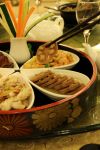Eating out in Guangzhou, Guangzhou, China.
My first restaurant meal in China. Where do I begin? The key expectation you need to have when eating out in China (really: eating, period) is that you will eat. Like, marathon-style. You don’t stop just because you are full. God help you if you ‘simply can’t fit anymore’—this isn’t the way it works out here. Someone will put more food in your bowl and look at you with that most Chinese of facial expressions: “Well, you do like it, right? Good, eat more then!”
Looking at the timestamps on my photos, we had new dishes coming out for a solid hour (they never come all at once). The whole meal lasted nearly two hours, which is not at all untypical, and doesn’t get broken up into appetizers or dessert, so you really just keep eating. And eating, and eating. In order of appearance above:
- Appetizer plate with stuffed lotus root, “Five Treasures” (shrimp, peanut, scallop and two other things), fried oysters, fried pork, and squid and vegetables
- Red wine, in this case not of the typical disgustingly sweet Chinese variety
- Crispy pork belly with lotus roots in casserole
- Mixed mushrooms and seafood stuffed in beancurd pouches
- Fresh fish of the day (as yet unidentified) in a ginger soy sauce
- Braised big head fish with pork belly, black mushroom and turnip in garlic
- Sweet dim sum dumpling with something in it, unidentified
- Fried chrysanthemum with orange tangy sauce
- Mushrooms and winter squash in a cream broth (not pictured)
For seven of us.
Flavor: 4 / 5
The appetizers left something to be desired—the lotus root was mushy and the rest of them nothing memorable. But the chicken (especially around that beloved bone) was tasty, moist and well-flavored. The smaller catch-of-the-day fishes had a distinct kick of flavor which was nicely matched (not overpowered) by the soy ginger sauce, and the beancurd pouches were yummy and fun to eat—just like the tofu-wrapped rice you get at Japanese restaurants, with better filling.
My favorite was the fish head, which was smooth, moist, exceptionally flavored by the rich pork belly and garlic sauce, and far too much fun to eat—this one in particular had a bit of a crispness on the outside to contrast the softness inside. For all you still walking on the vanilla side of culinary life, please go out and get yourself some fish head.
–
Fun: 3.5 / 5
Few food experiences compare with a first outing at a true Cantonese restaurant, family-style—especially not when you have a real Cantonese family to do it with. From the giant ornate glass lazy-susans to the flashy gold gilt interiors to, of course, the absolute butt ton of food, it’s a no-joke feast. The wine helped it all go down, but my stomach still had some expanding to do at the time of this dinner.
–
Funkiness: 3 / 5
If Mr. Chicken in picture #3 puts you off, this may not be the meal for you. But there wasn’t much else that was so terribly strange (and I don’t think anyone tackled that shriveled Mr. Chicken head). Pork belly: boooring.
I personally found the vegetable dishes more intriguing than the meat and fish dishes. Lotus root, while not terribly uncommon in Asian restaurants here, is indisputably unique, with its light crunch and hole-y shape. The spiky chrysanthemum, in the last picture, was a fascinating little treat (especially because I have no idea what it actually looks like in real life). The flower itself was very light tasting, with more of a starch than a vegetable texture. Deep-fried, with the orange sauce, it made for a great post-dinner snack.
And OK, OK, I’ll admit fish head is weird. I’ll give you a little Weird Dish secret tip, though. You don’t really need to dig through the whole fish head to get the biggest payoff. Fish cheeks have all the soft moistness of the rest of the fish with much less of the work—and there’s a lot of it. Next time you get a baked or fried whole fish, try probing the sides of the fish head for a bit to find those cheeks—its well worth it.








